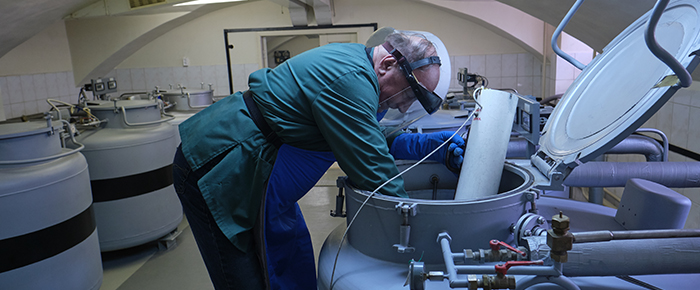
All specimens need to be labeled appropriately
The Fourth Edition and its addendum clearly state that all specimens require labels for identification. Each label should contain a unique ID that links directly to the inventory system’s database, listing all the necessary information about the sample, including donor information, diagnosis, diagnostic procedure, and specimen type. It should also record the volume of specimen remaining, the date/time of collection, timestamps for when the sample was received and/or processed, a history of additional processing or movement, and additional notes if the specimen has been potentially compromised. Other documents, like pathology reports and consent forms, can also be associated with the specimen’s ID.
It’s imperative that the labels used for specimen storage tightly adhere to the container irrespective of the storage conditions. Per the addendum, the labels should be composed of a strong, permanent adhesive that resists extreme temperatures, including immersion in liquid nitrogen Dewars (-196°C), as well as any other laboratory conditions they might experience during processing. Additionally, specimen labels and the ink used to print them should be tested prior to use.
Specimen location must be continuously tracked
ISBER recommends that all labels be printed with barcodes or radio-frequency identification (RFID) tags to track samples. Ideally, information regarding each sample’s location should also be entered into the system, allowing personnel to identify errors in specimen location. A detailed inventory system comprising unique identifiers for every freezer, refrigerator, storage cabinet, and liquid nitrogen tank should be used, in addition to having a convention for numbering racks, shelves, boxes, and the individual locations within each container. All this information should be assigned to each sample, with any changes in location tracked via an audit trail.
Container types
ISBER’s Fourth Edition Addendum lists quite a few detailed recommendations for cryogenic storage containers. Overall, those in charge of biobank sample storage must choose an appropriate container made of suitable material that will remain stable over the specimen’s lifespan. These materials must also show resistance to chemicals and have sufficient drainability to ensure maximum cell recovery. If required for medical use, the container should be made of materials that are USP class VI.
Closure integrity is a major focus of ISBER’s recommendations. They advocate against using standard screw-cap vials, as these types of containers often allow for contact between the specimen and liquid nitrogen. This can result in contamination of both the specimen and the liquid nitrogen supply, potentially ruining the entire bank of samples. ISBER recommends using bag-style tubing systems, laser-welded stoppers, and low-temperature stoppered vials instead. However, if an overwrap is used, cooling and warming protocols must be adjusted because the overwrap can provide additional insulation.
While ISBER recognizes that many vials are made of polypropylene, they note that it’s not used very much in pharmaceutical production because quality can vary significantly. Instead, they recommend using some of the newer plastic resins, like cyclic olefin co-polymers. These are more reliable and come with lower levels of particulates and moisture permeability.
When it comes to cell freezing bags, ISBER suggests using fluorinated ethylene propylene (FEP) in place of ethylene-vinyl acetate (EVA) or polyvinyl chloride (PVC). EVA bags can become brittle at extremely low temperatures, while PVC tubing can also become brittle and exhibit leaching of PVC plasticizers (which are used to make the tubing flexible) into the media. FEP appears to be more resistant to cold temperatures, with excellent strength and stability.
Computer-based inventory systems are required
ISBER has an entire section devoted to repository information management systems, which is referred to in its 2019 addendum when discussing the identification of specimens. It states clearly that all biobanks should use a computer-based inventory system for specimen tracking and sample management. The system in place should include a full audit trail, recording changes to specimen data. It should also manage which personnel are responsible for making changes, how the changes were made, as well as the date, time, and reason for the changes. This audit trail should generate reports automatically in an electronic system and provide read-only access. Additional audit trails may be necessary for personal health or other identifiable information depending on local, national, and international legislative authorities’ requirements.
Ideally, the system should also be interoperable with other health-related applications, such as electronic medical records, cancer registries, pathology systems, and environmental monitoring systems. This helps keep data re-entry to a minimum and maintains the identification and correction of data errors to a single platform. The inventory system should also account for different storage environments and quickly record the mass movement of samples from one location to another.
Finally, the system needs to be validated before use, regardless of its source (e.g., commercial software or customized system). Checks, controls, and strict policies need to be put in place that ensure the system runs as smoothly and accurately as possible.
The guidelines outlined in the ISBER addendum are not full-proof but can go a long way to ensure your samples stored under cryogenic conditions remain secure. Always ensure you are using the right labels to identify and track your samples, the appropriate containers to store them, and the best software to manage your inventory.
LabTAG by GA International is a leading manufacturer of high-performance specialty labels and a supplier of identification solutions used in research and medical labs as well as healthcare institutions.